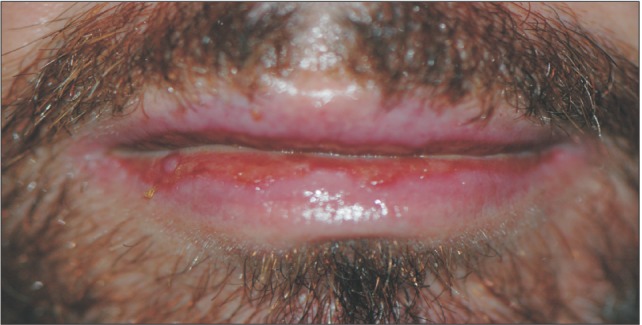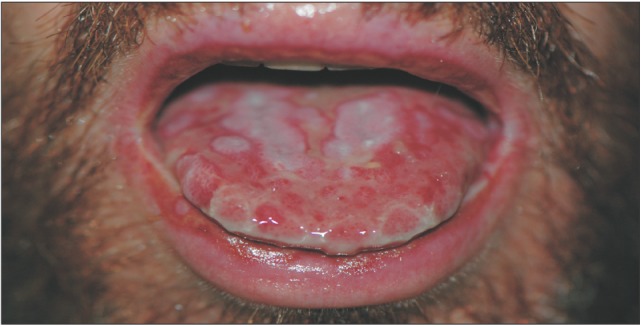J Korean Assoc Oral Maxillofac Surg.
2017 Feb;43(1):57-60. 10.5125/jkaoms.2017.43.1.57.
Stevens-Johnson syndrome and abuse of anabolic steroids
- Affiliations
-
- 1Department of ENT, General Hospital of Siena, University of Siena, Siena, Italy. mailarticoli@libero.it
- 2Department of Dentistry, General Hospital of Siena, University of Siena, Siena, Italy.
- KMID: 2385073
- DOI: http://doi.org/10.5125/jkaoms.2017.43.1.57
Abstract
- Stevens-Johnson syndrome (SJS) is characterized by mucocutaneous tenderness and typical hemorrhagic erosions, erythema and epidermal detachment presenting as blisters and areas of denuded skin. SJS is often observed after drug use as well as after bacterial or viral infections. Several drugs are at high risk of inducing SJS, but there are no cases in the English literature regarding anabolic steroid use triggering SJS. In our paper, we describe a case in which use of anabolic androgenic steroids (AAS) was associated with SJS. The patient participated in competitive body-building and regularly took variable doses of AAS. Initial symptoms (headache, weakness, pharyngodynia, and fever) were ignored. After a week he presented to the Emergency Department with a burning sensation on the mouth, lips, and eyes. Painful, erythematous, maculopapular, and vesicular lesions appeared all over the body, including on the genitals. During hospitalization, he also developed a cardiac complication. The patient had not taken any drugs except AAS.
MeSH Terms
Figure
Reference
-
1. Stevens AM, Johnson FC. A new eruptive fever associated with stomatitis and ophthalmia; report of two cases in children. Am J Dis Child. 1922; 24:526–533.2. Lyell A. Toxic epidermal necrolysis: an eruption resembling scalding of the skin. Br J Dermatol. 1956; 68:355–361. PMID: 13374196.
Article3. Roujeau JC. Stevens-Johnson syndrome and toxic epidermal necrolysis are severity variants of the same disease which differs from erythema multiforme. J Dermatol. 1997; 24:726–729. PMID: 9433029.
Article4. Bastuji-Garin S, Rzany B, Stern RS, Shear NH, Naldi L, Roujeau JC. Clinical classification of cases of toxic epidermal necrolysis, Stevens-Johnson syndrome, and erythema multiforme. Arch Dermatol. 1993; 129:92–96. PMID: 8420497.
Article5. Yip LW, Thong BY, Lim J, Tan AW, Wong HB, Handa S, et al. Ocular manifestations and complications of Stevens-Johnson syndrome and toxic epidermal necrolysis: an Asian series. Allergy. 2007; 62:527–531. PMID: 17313402.
Article6. Sargenti Neto S, de Paulo LF, Rosa RR, Durighetto AF. Stevens-Johnson syndrome: an oral viewpoint. Int J Pediatr Otorhinolaryngol. 2013; 77:284–286. PMID: 23149180.
Article7. Sawant SP, Amin AS. Mycoplasma pneumoniae associated Stevens-Johnson syndrome in an eight-year-old girl. Pediatr Infect Dis J. 2013; 5:13–15.8. Basaria S. Androgen abuse in athletes: detection and consequences. J Clin Endocrinol Metab. 2010; 95:1533–1543. PMID: 20139230.
Article9. Kicman AT. Pharmacology of anabolic steroids. Br J Pharmacol. 2008; 154:502–521. PMID: 18500378.
Article10. Fineschi V. Anabolic androgenic steroids (AAS) as doping agents: chemical structures, metabolism, cellular responses, physiological and pathological effects. Mini Rev Med Chem. 2011; 11:359–361. PMID: 21443515.11. Mokhtari F, Nikyar Z, Naeini BA, Esfahani AA, Rahmani S. Adverse cutaneous drug reactions: eight year assessment in hospitalized patients. J Res Med Sci. 2014; 19:720–725. PMID: 25422656.12. Chung WH, Hung SI, Hong HS, Hsih MS, Yang LC, Ho HC, et al. Medical genetics: a marker for Stevens-Johnson syndrome. Nature. 2004; 428:486. PMID: 15057820.13. Hung SI, Chung WH, Liou LB, Chu CC, Lin M, Huang HP, et al. HLA-B*5801 allele as a genetic marker for severe cutaneous adverse reactions caused by allopurinol. Proc Natl Acad Sci U S A. 2005; 102:4134–4139. PMID: 15743917.14. Fineschi V, Riezzo I, Centini F, Silingardi E, Licata M, Beduschi G, et al. Sudden cardiac death during anabolic steroid abuse: morphologic and toxicologic findings in two fatal cases of bodybuilders. Int J Legal Med. 2007; 121:48–53. PMID: 16292586.
Article15. Scully C, Bagan J. Oral mucosal diseases: erythema multiforme. Br J Oral Maxillofac Surg. 2008; 46:90–95. PMID: 17767983.
Article16. van Amsterdam J, Opperhuizen A, Hartgens F. Adverse health effects of anabolic-androgenic steroids. Regul Toxicol Pharmacol. 2010; 57:117–123. PMID: 20153798.
Article
- Full Text Links
- Actions
-
Cited
- CITED
-
- Close
- Share
- Similar articles
-
- Clinical Study of Stevens-Johnson Syndrome
- A Case of Stevens-Johnson Syndrome in a Hypoxic Brain Injury Patient Treated with Carbamazepine
- A Case of Secondary Milia Associated with Stevens-Johnson Syndrome
- Five Cases of Stevens-Johnson Syndrome May Be Associated with Methazolamide Treatment
- A comparative clinical study of toxic epidermal necrolysis and Stevens-Johnson syndrome



